Breaking Cycles, Seeing Time
Listen to this text
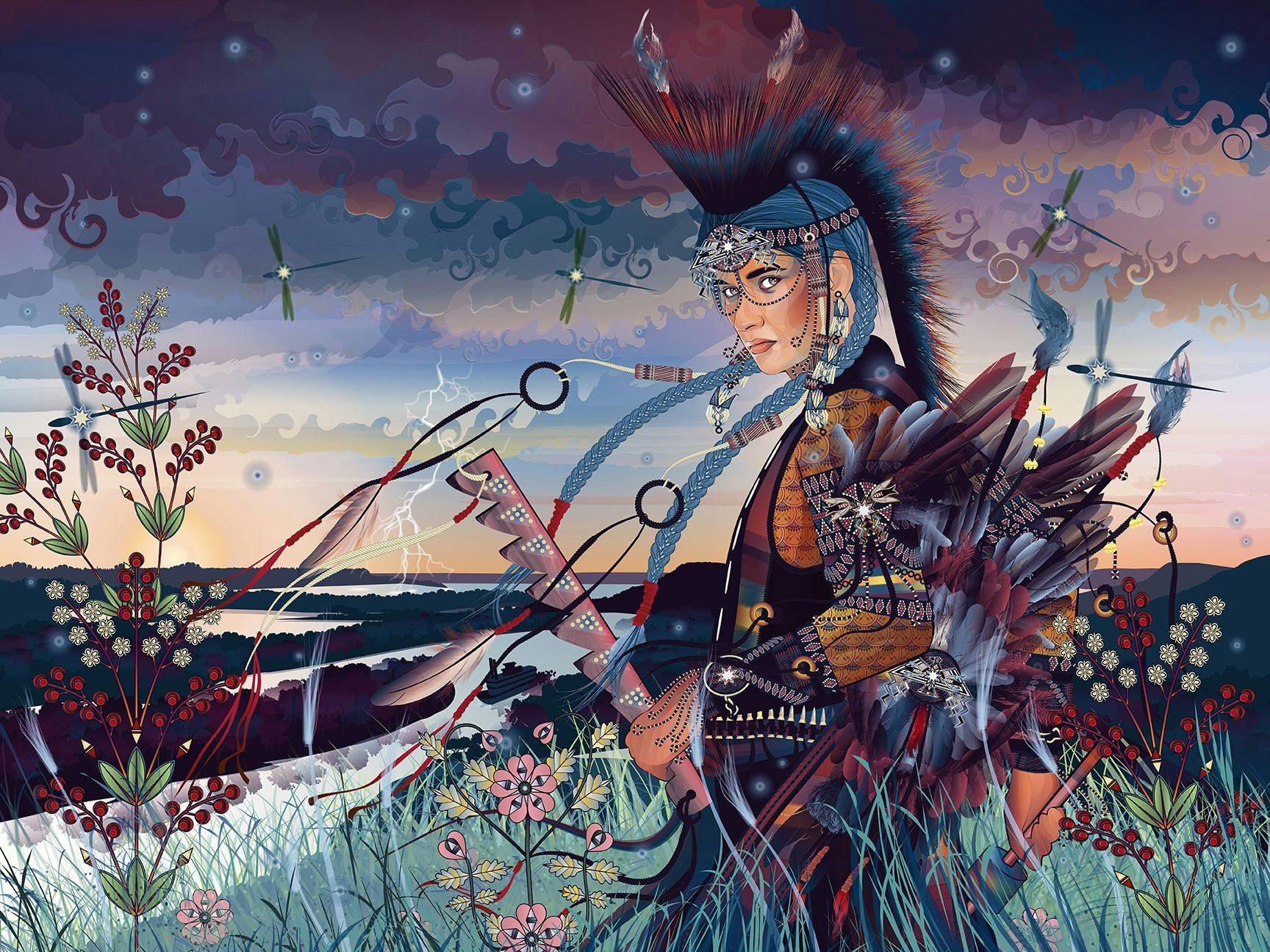
What can we learn if we listen to the land? Marlena Myles asks us to listen and see transcendently, to abandon colonial ways of thinking and constructing time. Spanning multiple mediums, including coloring pages, essays, augmented reality, animation, and illustration, her work powerfully centers Native culture and beliefs.
From the delicate outline of a sage plant to the Uŋktehi (Dakota water protector spirit) that travels with her in augmented reality, Myles presents us with a vision of art and technology as prismatic as her murals, using technologies to draw, shape, and envision new narratives while revitalizing our relationship to the Earth. I’m thinking as I write these words of her mural Kapemni (Mirroring), located close to the confluence of the Minnesota and Mississippi Rivers, near destroyed Dakota burial mounds. Colorful triangles reflect each other in a gesture to “as above, so below,” the idea that land and heaven mirror each other; in Dakota belief, the Mississippi River is reflected above in the Milky Way, the spirit road.
In a time when automation and AI purport to replace humans, the stories held behind Kapemni, much like the rest of Myles’s work, remind us to move beyond the colonial project of a rational “universal” man, a project entwined in so much of our technology.
Halfway through our conversation, Myles and I inevitably end up talking about AI and generative art. “AI doesn’t understand symbols,” she says. “It’s something that’s never had eyes, never touched anything. With Native art, it wouldn't know what the symbols meant.” To truly see Myles’s work is to look with deeply human eyes — between above and below, between ancestral and present day, between the computer screen and the return of your feet to the land, in all its stories and possibilities.
Marlena and I spoke via Zoom on February 20, 2023; the following conversation has been lightly edited for length and clarity.
— Xiaowei R. Wang
Xiaowei R. Wang: So much of your work draws upon past, present, and future in the context of knowledge sharing and community, like your Dakota Spirit Walk project and Dakhóta Thamákhočhe, the Dakota Land Maps. What is your research process like for these pieces?
Marlena Myles: Those maps were made [by] looking at older maps that people had written down, like the first French explorers that came to Minnesota. They recorded the Native names; they didn’t rename things after themselves. It was during a later period, during the Lewis and Clark time, that they started giving places non-Native names. So you can look at older maps and find information, and people in the community also have this information. It’s about incorporating contemporary places as well as working with people who fluently speak the language to make something I wish I had when I was younger.
When I grew up in Minneapolis, I lived in a Native urban community called Little Earth, and I went to a Native magnet school. Outside of those two areas, I didn’t see anything that showed this was Dakota homelands. I remember in fourth grade, we went to Fort Snelling [in St. Paul], and the tour told the story of pioneer days, showing us what blacksmithing looks like and what an old classroom looks like. I was there with a class of 95% Native kids — but they didn’t teach us that Fort Snelling was where the Dakota people were basically put into a concentration camp and then exiled from Minnesota in the 1860s. I don’t understand how you can take all these Native kids to a place like that and not show them that information.
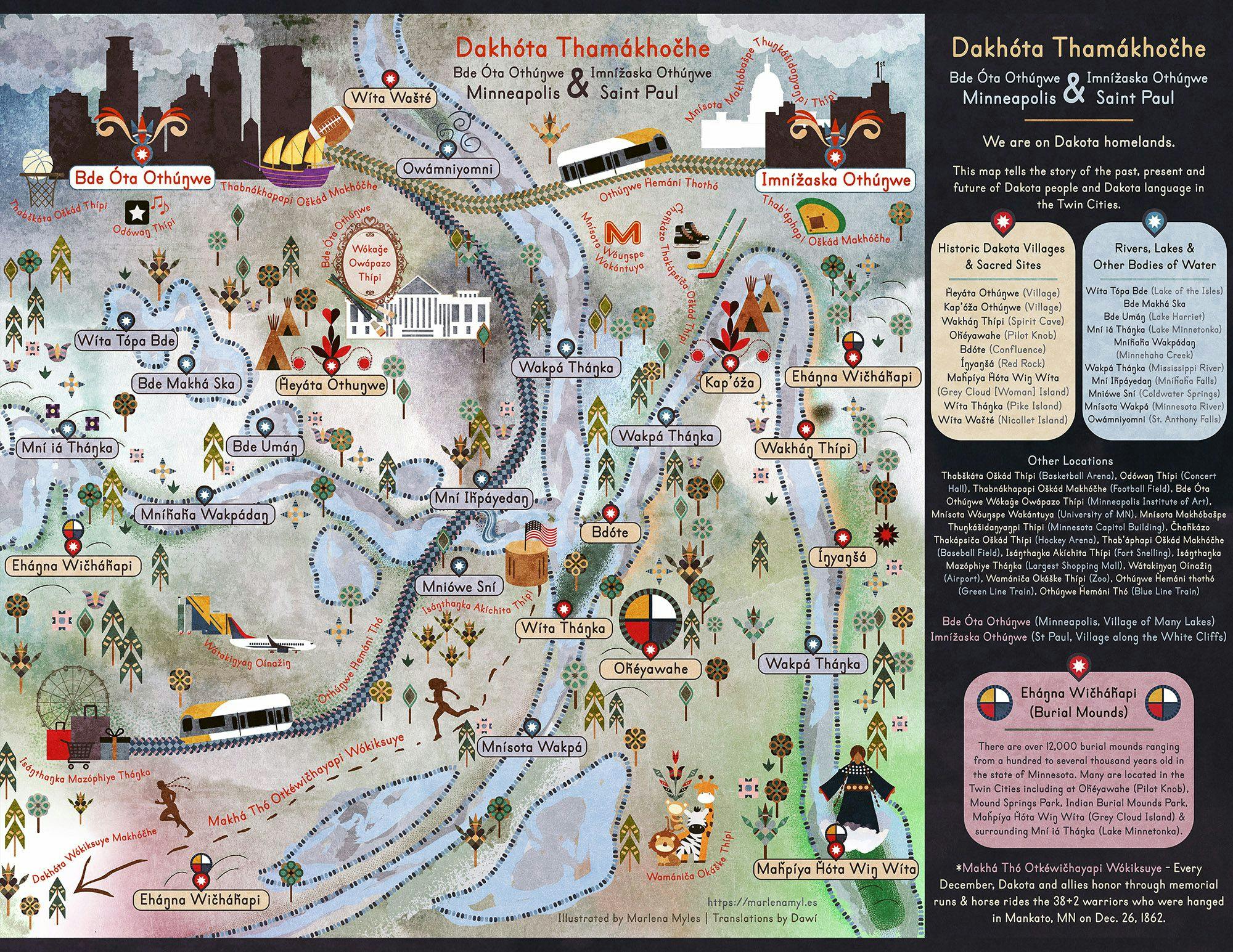
The Dakota Land Map, I think it gives people a big-picture view of the city. A lot of places still have Dakota names here. I ask people, what does Minnesota mean? And most people don’t know; they never thought about it before. I try to provide this information so that you can remove the ignorance and start seeing the deeper meanings here.
The Dakota Spirit Walk, my augmented reality project, really is site-specific; it is about the place. You’re going to the site and you’re engaging with the weather, the smells, the sounds of the plants that are growing. Your phone is opening your eyes to the Dakota stories there. We didn’t have a written language prior to the arrival of Europeans, so we stored our stories in the land — sort of like data — the way today you might use your computer, your desktop icons, where your photos are, where you see the icon that represents stories. When I see the Mississippi River, I know what that represents to us. The stories that are there with the river — not just it as a relative or a resource — it reflects our philosophical worldview. We believe what’s on Earth is reflected above us, so we believe the Milky Way is the reflection of the Mississippi River, and the Milky Way is the spirit road we travel when we leave this world. All along the Mississippi River, there’s hundreds of burial mounds because my ancestors wanted to be close to that spirit road. When I see the river, I understand the power that’s there, that it connects me to ancestors, that our villages were along the river as well. In creating the augmented reality piece, it allows the people to see the river as more than just a resource.
Xiaowei: That sense of time, as well as a different sense of what technology can be or do, is so present in your artwork — that the past is not just a plaque or something that is distant, but that the past influences the future. I’m curious about the ways you approach time in your work as well as the ways you’re rethinking what technology can do.
Marlena: Technology, even something like a smartphone, is one of the greatest things human beings have invented, and we use it for such frivolous things. But when you start creating something that engages people’s mindsets and creates new memories in their brains, you kind of have to hack people’s brains. If we were aware of every little thing in our environment, it would be overwhelming. With things like social media, our attention spans are decreasing. Instead of a headline, people want a thirty-two-second TikTok video, not even a five-minute video.
I want to break that cycle. With my work, you can go outside, you have your phone, and you are no longer rushed, but safe. It’s showing you a different perspective of the world. Especially now, coming out of the pandemic, a lot of people are anxious, and having access to nature through Native American teachings is important — it’s such a stark contrast to American society. Technology can engage in a way that wasn’t possible before, because you can embed data into your phone and put it in places. For us, the land has always been a teacher; my work allows people to see it from my perspective, and to do it in a way that isn’t tragic or traumatic.
For Native people, the period of being at war with Europeans was such a tiny little segment of our human history. That shouldn’t be all that is taught about us.
My brain is in love with patterns and math still, like when I was a kid. When you look at plants, a lot of them have a sequence to the way they grow, and their leaves alternate. Most people can name twenty brands at the gas stations, but it’s harder for them to name five plants outside their window. Seeing the pollination that needs to happen so that you can have an apple, for example, helps me to put away my phone and actually enjoy the beauty of the earth. This has been going on for millions of years, this relationship, and if humans all disappeared, this would still be going on: seeing time, the past and the present, seeing how all of these plants and animals, how they all passed on their strengths so that they can continue to survive into the next generation. I know that some Native people say it’s hard to live in two worlds, between American society and a Dakota way of living. Going out into nature you can reconnect with your ancestors and with that way of life.
Before 1851, European people strove to be in our society, because we had a kinship-based society and we wouldn’t trade with you unless you were adopted into or married into the tribe. After the treaties were signed, they had access to the land and no longer put in the effort. Fast forward to now, where most people don’t own any land at all. When Native people say land back, they mean land back to Native people and also land back as relatives, because most people don’t have any relationship with the earth now. Even when you go to a state park, you have to pay money. In Minneapolis, you see how disenfranchisement in the past has affected the present. For example, you see how historically Black communities have been disenfranchised when the city took away businesses and built highways through Black neighborhoods. We’re all in it together; when one person is put down, one group is put down, we can’t go forward as people unless we make it right.
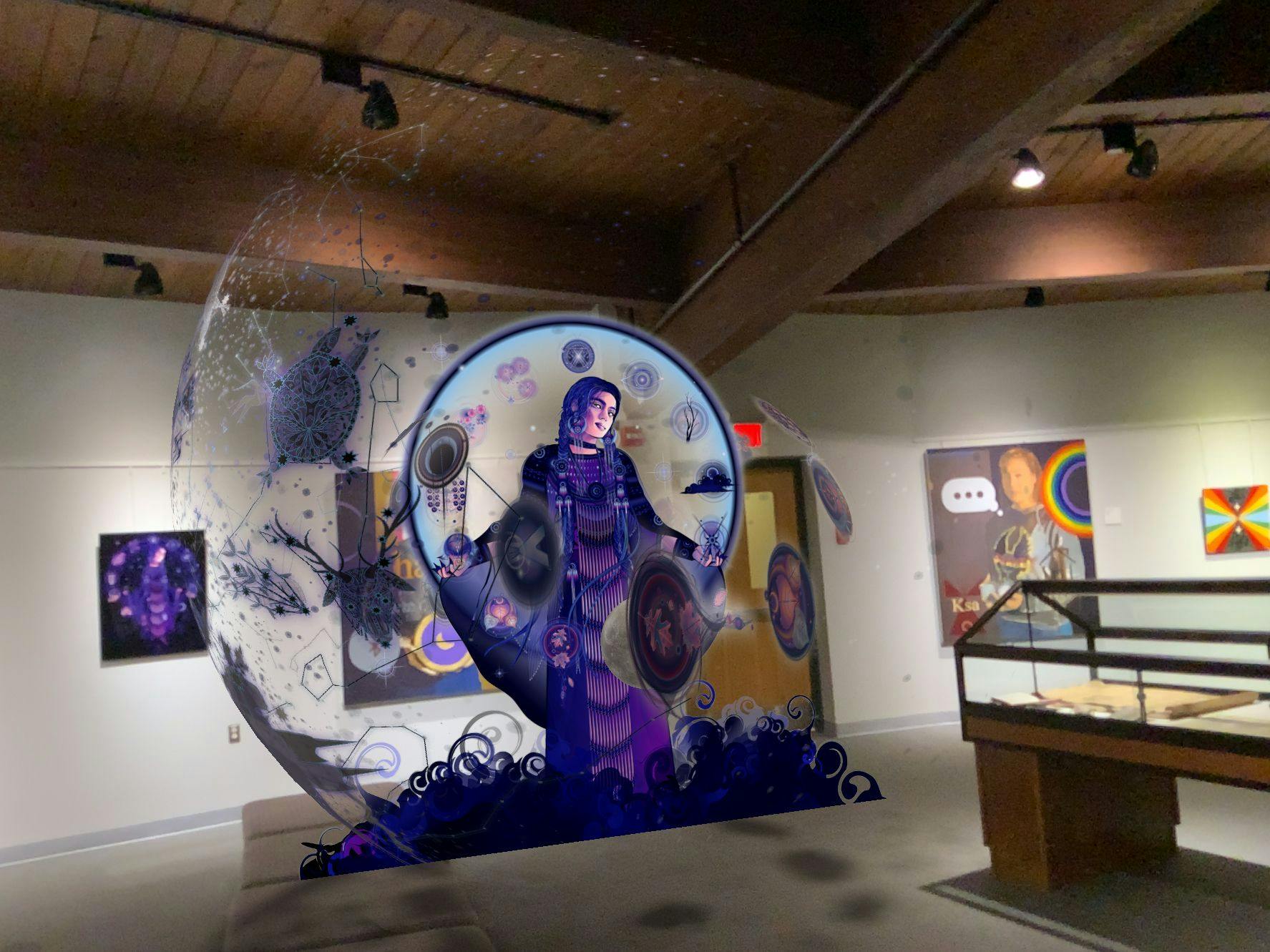
Xiaowei: Speaking of generations, I’m curious how you move across so many mediums, from AR to children’s coloring pages, and also what you’re hoping the next generation can receive from your work.
Marlena: Being self-taught, I know what I want to create and can figure out the tools I need to get there. A lot of digital artists, we often share our tutorials. Everything I do falls underneath one umbrella, even though it might have a different use for people; whether it’s an educational resource or material resource like fabric, it’s providing something that we currently don’t have in society. It’s often things I wish I could have had when I was younger, or things I see are needed in my community.
You know, some kids are really shy. When I give them a worksheet of sage, they know that sage is medicine, and it puts their mindset at ease and they become less anxious. While they are coloring, I’ll ask them, “Do you burn this at home?,” and also talk about their life at home. Some people think coloring sheets are just coloring sheets, but every now and then I think you can really connect deeply one-on-one with a young person through artwork. These kids appreciate that the artwork is authentic, that they aren’t being tokenized or stereotyped. I always tell them that as Native people, we’ve always been innovative; any material we had, we just incorporated it into our culture. The coloring sheets show the kids that these plant medicines have a healing power — and that’s a source of power, especially when you might grow up poor and everyone tells these tragic stories about you and your culture. For these kids, it’s a bigger way of seeing that their culture is much more than that part of history, a bigger worldview of their culture.
Art is the talent that I have, and that’s what I try to give back and be generous with.
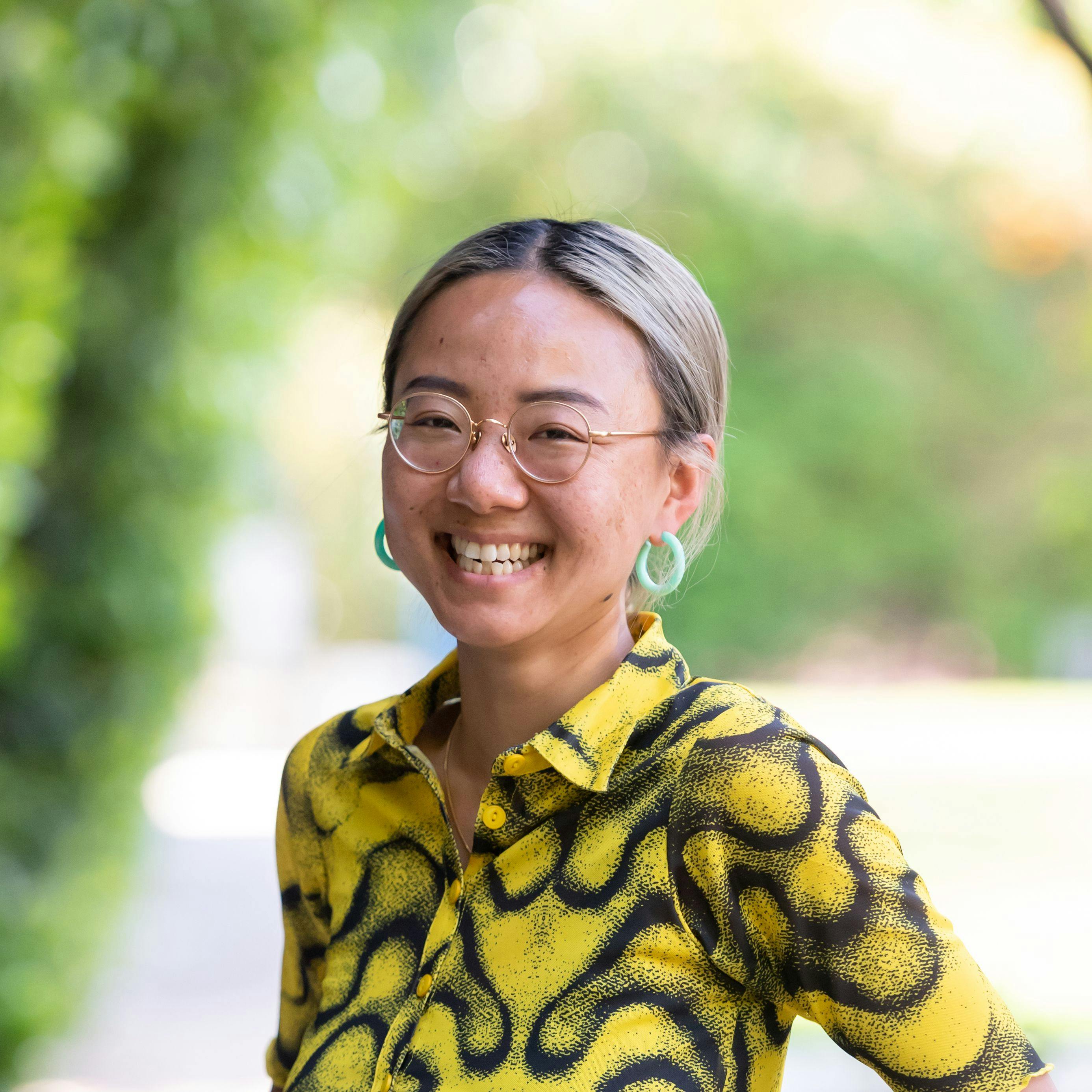
Xiaowei R. Wang is an artist, writer, organizer, and coder, whose multidisciplinary work sits at the intersection of tech, social, and environmental justice. Wang is the author of Blockchain Chicken Farm: And Other Stories of Tech in China's Countryside, a 2023 National Book Foundation Science and Literature Award winner. They are a research fellow at the Center on Race and Digital Justice and a Senior Civic Media Fellow at USC Annenberg.
Website
internetresear.ch
Instagram
@xrwang88
Photo by Chloe Jackman
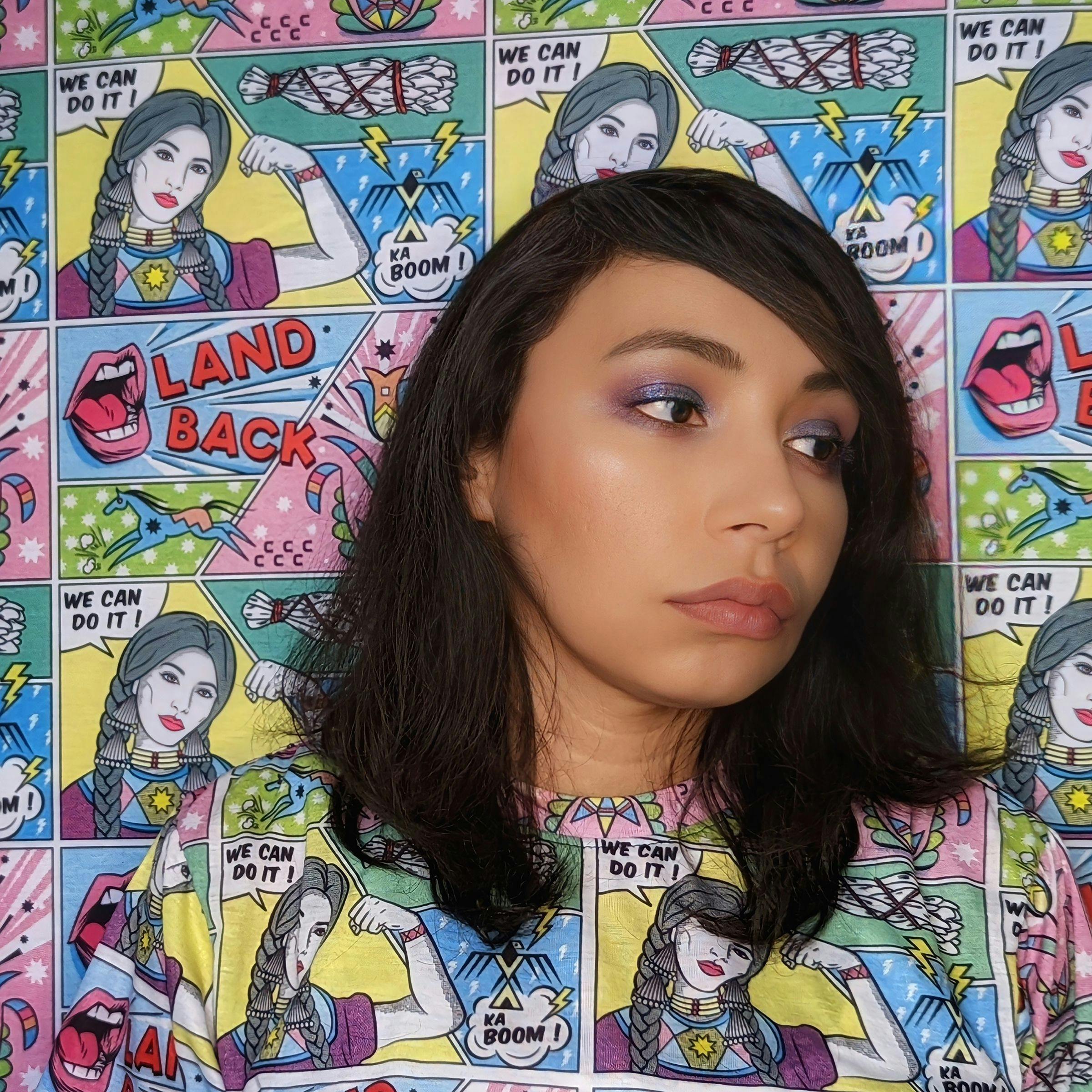
Marlena Myles is a self-taught Native American artist and enrolled member of the Spirit Lake Dakota tribe living in Saint Paul, Minnesota. Myles's art brings modernity to Indigenous history, languages, and oral traditions while using the land as a teacher, helping the public to understand the significance of Native land, oral traditions, and history. Her professional work includes children’s books, augmented reality, murals, fabrics, and animations, and she has exhibited her work at the Minneapolis Institute of Art, The Museum of Russian Art, Red Cloud Heritage Center, and the Minnesota Museum of American Art. Her first permanent site-specific augmented reality public art installation, Dakota Spirit Walk, is available on the Revelo AR app. Her second augmented reality installation, Dakota Sacred Hoop Walk, is opening in spring 2023 at the Minnesota Landscape Arboretum. Myles operates her own Dakota publishing company called Wíyouŋkihipi (We Are Capable) Productions to create a platform that educates and honors the culture, language, and history of Dakota people.
Website
marlenamyl.es
Instagram
@mylesdesigns
Twitter
@thisismarlena
Facebook
@mylesdesigns
Photo by Marlena Myles